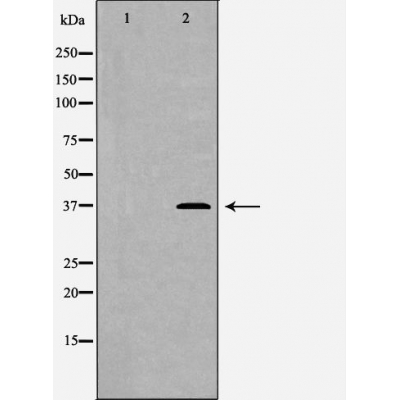AKR1A1 Antibody - #DF6213
| Product: | AKR1A1 Antibody |
| Catalog: | DF6213 |
| Description: | Rabbit polyclonal antibody to AKR1A1 |
| Application: | WB IHC IF/ICC |
| Reactivity: | Human, Mouse, Rat |
| Prediction: | Pig, Bovine, Horse, Sheep, Dog, Chicken, Xenopus |
| Mol.Wt.: | 37kDa; 37kD(Calculated). |
| Uniprot: | P14550 |
| RRID: | AB_2838179 |
Product Info
*The optimal dilutions should be determined by the end user. For optimal experimental results, antibody reuse is not recommended.
*Tips:
WB: For western blot detection of denatured protein samples. IHC: For immunohistochemical detection of paraffin sections (IHC-p) or frozen sections (IHC-f) of tissue samples. IF/ICC: For immunofluorescence detection of cell samples. ELISA(peptide): For ELISA detection of antigenic peptide.
Cite Format: Affinity Biosciences Cat# DF6213, RRID:AB_2838179.
Fold/Unfold
AK1A1_HUMAN; Akr1a1; Alcohol dehydrogenase [NADP+]; Alcohol dehydrogenase; Aldehyde reductase; Aldo keto reductase family 1 member A1 (aldehyde reductase); Aldo-keto reductase family 1 member A1; ALDR1; ALR; ARM; DD3; MGC12529; MGC1380;
Immunogens
A synthesized peptide derived from human AKR1A1, corresponding to a region within C-terminal amino acids.
Widely expressed. Highly expressed in kidney, salivary gland and liver. Detected in trachea, stomach, brain, lung, prostate, placenta, mammary gland, small intestine and lung.
- P14550 AK1A1_HUMAN:
- Protein BLAST With
- NCBI/
- ExPASy/
- Uniprot
MAASCVLLHTGQKMPLIGLGTWKSEPGQVKAAVKYALSVGYRHIDCAAIYGNEPEIGEALKEDVGPGKAVPREELFVTSKLWNTKHHPEDVEPALRKTLADLQLEYLDLYLMHWPYAFERGDNPFPKNADGTICYDSTHYKETWKALEALVAKGLVQALGLSNFNSRQIDDILSVASVRPAVLQVECHPYLAQNELIAHCQARGLEVTAYSPLGSSDRAWRDPDEPVLLEEPVVLALAEKYGRSPAQILLRWQVQRKVICIPKSITPSRILQNIKVFDFTFSPEEMKQLNALNKNWRYIVPMLTVDGKRVPRDAGHPLYPFNDPY
Predictions
Score>80(red) has high confidence and is suggested to be used for WB detection. *The prediction model is mainly based on the alignment of immunogen sequences, the results are for reference only, not as the basis of quality assurance.
High(score>80) Medium(80>score>50) Low(score<50) No confidence
Research Backgrounds
Catalyzes the NADPH-dependent reduction of a wide variety of carbonyl-containing compounds to their corresponding alcohols. Displays enzymatic activity towards endogenous metabolites such as aromatic and aliphatic aldehydes, ketones, monosaccharides and bile acids, with a preference for negatively charged substrates, such as glucuronate and succinic semialdehyde. Functions as a detoxifiying enzyme by reducing a range of toxic aldehydes. Reduces methylglyoxal and 3-deoxyglucosone, which are present at elevated levels under hyperglycemic conditions and are cytotoxic. Involved also in the detoxification of lipid-derived aldehydes like acrolein (By similarity). Plays a role in the activation of procarcinogens, such as polycyclic aromatic hydrocarbon trans-dihydrodiols, and in the metabolism of various xenobiotics and drugs, including the anthracyclines doxorubicin (DOX) and daunorubicin (DAUN). Displays no reductase activity towards retinoids (By similarity).
Cytoplasm>Cytosol. Apical cell membrane.
Widely expressed. Highly expressed in kidney, salivary gland and liver. Detected in trachea, stomach, brain, lung, prostate, placenta, mammary gland, small intestine and lung.
Belongs to the aldo/keto reductase family.
Research Fields
· Metabolism > Carbohydrate metabolism > Glycolysis / Gluconeogenesis.
· Metabolism > Carbohydrate metabolism > Pentose and glucuronate interconversions.
· Metabolism > Lipid metabolism > Glycerolipid metabolism.
· Metabolism > Global and overview maps > Metabolic pathways.
Restrictive clause
Affinity Biosciences tests all products strictly. Citations are provided as a resource for additional applications that have not been validated by Affinity Biosciences. Please choose the appropriate format for each application and consult Materials and Methods sections for additional details about the use of any product in these publications.
For Research Use Only.
Not for use in diagnostic or therapeutic procedures. Not for resale. Not for distribution without written consent. Affinity Biosciences will not be held responsible for patent infringement or other violations that may occur with the use of our products. Affinity Biosciences, Affinity Biosciences Logo and all other trademarks are the property of Affinity Biosciences LTD.
